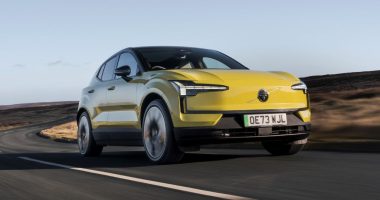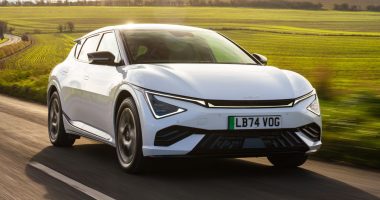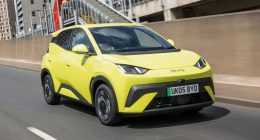The F-Pace is the largest car in Jaguar’s portfolio and one widely renowned for being blessed with class-leading dynamics and sharp looks. This facelifted version of the load lugger promises much of the same, albeit with an interior that is more inviting – and tech packed – than ever before.
Table of Contents
THE F-PACE: WHAT’S NOT TO LIKE?
If you are in the market for a slickly styled premium SUV then the F-Pace deserves a spot on your shortlist. After spending a couple of minutes walking around this latest car, we quickly concluded the design team has done an A1 job of making this five-seater even easier on the eye. The changes worth pointing out comprise super slim headlights that incorporate two-piece J-blade DRLs and LEDs – or optional Pixel LEDs – a reprofiled bonnet complete with power bulge and larger grille either side of which sit hollowed air intakes. The rear hasn’t gone untouched as here the tail-lights are, yes, you guessed it, slimmer and inherit the chicane arrangement first seen on the all-electric I-Pace crossover. Also new is the tail-gate, rear bumper and associated trim arrangement. If the car doesn’t look intimidating enough in regular guise, then Jaguar has that sorted: opting for the ‘Black Exterior Pack’ (£650) dechromes the body and introduces smoked trim pieces and finishers.
A RUN THROUGH THE MODELS
The F-Pace is built in three regular flavours before special ‘Black’, ‘Sport’ and the 178mph ‘SVR’ models are taken into consideration. Tested here is mid-spec ‘SE’. Less money gets you into ‘S’ and for a few thousand pounds more ‘HSE’. However, we think our choice strikes a decent balance between price and equipment before options are added. So, 20-inch 10-spoke gloss black wheels – a nice match especially if you opt for the black visual pack – a powered tail-gate, and R-Dynamic badges on the grille and boot lid feature. If cash reserves allow, these can be joined by privacy glass (£415) for added security, a fixed panoramic glass sunroof (£1,275) that bathes the cabin in natural light, and deep ‘Firenze Red’ metallic paint (£740) that pops in the summer sun. The exterior of the F-Pace has always won plaudits and with some clever styling add-ons you can make a good-looking SUV a real show-stopper. In comparison, the interior has previously been a chink in the British-built car’s armoury – but Jaguar insists it has learned from past mistakes.
A PREMIUM FEELING CABIN
Before the facelifted F-Pace arrived, there was little to get excited about on the inside as overall quality was on a level that struggled to worry its German rivals. Also lagging was the technology; dated and lacklustre, the car faced being left behind. This update has improved things massively, however, and allows the F-Pace to turn the tables on Mercedes, Audi and BMW. Plush materials and intricate detailing are real talking points but the real show-stopper is the reconfigured centre console that is now home to a curved 11.4-inch touchscreen. Incorporating JLR’s latest ‘Pivi Pro’ software, the display is positioned at a nice height which helps when operating it on the move. Apple CarPlay and Android Auto compatible, the unit is blessed with slick graphics, fast processing times and endless options. An interactive driver display common to other Jaguars can be tailored to show different information, although the touch-sensitive steering wheel buttons prove fiddly. As before, contrast stitching and leather upholstered seats are standard with wireless smartphone charging (£300) an option for the first time alongside a great sounding Meridian stereo (£840).
SPACE FOR FIVE INSIDE – JUST
Because the F-Pace is not the widest medium-sized SUV, it can only accommodate two adults in the second row in real comfort as the back of the front centre armrest column impedes leg and foot space for the middle seat passenger. The floor is not entirely flat, either, so sliding across into position is a bit of a chore. Jaguar does not offer a 7-seat option, but the boot is still a useful size and either matches or betters the competition. With the middle chairs in use, it weighs in at 650-litres and extends to 1,740-litres when these are folded flat. Tie-down points and nets help secure precious cargo in place both quickly and easily and the 40/20/40 split-folding arrangement allows for longer items like a pair of skis to be slid straight down the middle. One new piece of tech that has been introduced is air ionisation. A £60 filtration system, this is said to be capable of improving air quality within the cabin by removing allergens and common viruses.
ENGINES ARE MILDLY ELECTRIFIED
The projected big-sellers are the diesel engines – two 4-cylinder 2-litre units tuned to 161bhp and 201bhp respectively, and a meatier 3-litre 6-cylinder. Now with the added benefit of mild-hybrid assistance, the mid-range motor is hushed, linear and not short on pulling power even with its own weight, four grown adults and a boot load of luggage to haul about. Utilising a belt-integrated starter generator harvests energy under braking to later assist acceleration and optimise the stop-start system. Considering real-world performance, you can still expect to achieve 45mpg even in four-wheel-drive guise. Developed by ZF, the 8-speed automatic gearbox is the icing on the cake; cog swaps are slick and there is not the jerkiness that afflicts some rivals’ when you come to nose-to-bumper tail-backs or bumbling around town. Ride and handling-wise, the F-Pace is hard to fault and is the only choice for motorists who appreciate deft body control, sharp steering and a constant stream of reassuring grip in the wet or the dry. None of this comes at the expense of everyday comfort, although on the largest wheel sizes the dampers’ effectiveness is lessened somewhat.
PROS & CONS
+ Wins in the looks department
+ Cabin is a massive improvement
+ Fun to drive and economical
– Some rivals are roomier
– Larger wheels hurt the ride
– Poor tail-pipe emissions
MULTIMEDIA: The star of the F-Pace’s cabin is unquestionably the super slick and quick-to-respond ‘Pivo Pro’ touchscreen. The homepage is spilt into three sections – navigation, media and phone settings – and being roughly the size of an average handheld tablet means inputs are relatively easy on the move. Some physical buttons would be a help as the screen attracts prints all too easily.

DRIVING: One aspect that didn’t need tinkering as part of this mid-cycle refresh was the way the F-Pace points and steers. Using double wishbones at the front and a multi-link rear axle – a set-up shared with its XE and XF siblings as they all deploy the same iQ-AL platform – guarantees engaging handling and means it is as sporty to drive as it looks. Few rivals run the Jaguar close.

INTERIOR: Most of the in-car functions are controlled via the touchscreen, although there is a small panel directly beneath it with two knurled dials – one for the driver, and one for the front seat passenger – that operate heating and ventilation. The centre console is also pretty minimalist with the biggest change seeing the old rotary gear selector make way for a stubby ‘palm shifter’.

PRACTICALITY: As a premium family SUV the F-Pace isn’t the roomiest on the inside but neither is it disgraced by the competition as space in the front is brilliant and there is plenty of leg and knee room for two adults in the back. The full-length panoramic glass sunroof is a really nice feature but it does come at the expense of headspace which six-foot-plus passengers are sure to notice.

SPECIFICATION
Price: £52,940 (as tested)
Engine: 2-litre, 4cyl turbo diesel MHEV
Power/torque: 201bhp/317lb ft
Transmission: 8-speed automatic, four-wheel-drive
0-60mph: 7.6 seconds
Top speed: 130mph
Economy/CO2: 45mpg/165g/Km









